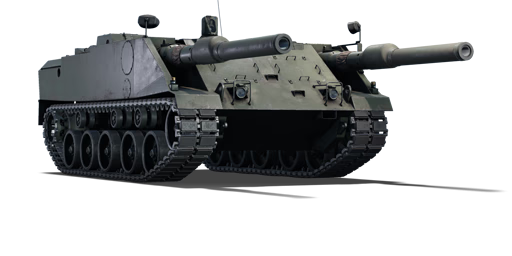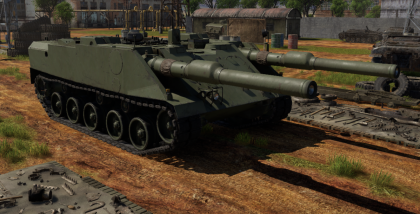Difference between revisions of "VT1-2"
m (→Usage in battles) (Tag: Visual edit) |
m (→History: and Media) (Tag: Visual edit) |
||
| Line 225: | Line 225: | ||
== History == | == History == | ||
| − | + | The project for an experimental turretless tank was started for development in Germany in the early 70’s as part of the replacement program for the Leopard 1. The unusual layout of the “casemate” tank type had several advantages: the possibility of installing two cannons at once, increased protection due to low silhouette and enhanced protection in the hull front profile and also increased mobility due to a reduced weight compared to traditional tanks. As part of this innovative project, two vehicles were built under the general name of Versuchsträger (German: experimental platform). The first VT1-1 prototype was placed on a shortened chassis and was equipped with two 105mm rifled cannons with manual loading. | |
| + | |||
| + | On the second VT1-2, two 120 mm calibre smoothbore cannons were used - the left cannon mounted with an automatic loader mechanism. Both of these prototypes used a number of parts and assemblies from the European “long-term production” experimental KPz-70. Since both vehicles were intended exclusively for the testing and development of new battle tactics, they were made from structural non-armour steel. Tests carried out by several NATO block countries, but they all left the project one by one and in 1985, Germany itself refused further development in favour of developing the Leopard 2 which was created according to a classic tank scheme. | ||
| + | |||
| + | ''- From [[wt:en/news/6400-operation-shipyard-vt1-2-doppelrohr-kasemattpanzer-en|News]]'' | ||
== Media == | == Media == | ||
| − | + | https://www.youtube.com/watch?v=o_425jH2a48 | |
| + | [[File:War Thunder Screenshot 2019.10.18 - 20.07.56.43.png|left|thumb]] | ||
== See also == | == See also == | ||
Revision as of 10:59, 18 October 2019
Contents
Description
The Doppelrohr-Kasemattpanzer Versuchsträger VT1-2 is a gift rank VI German tank destroyer
with a battle rating of 8.3 (AB) and 8.7 (RB/SB). It was introduced during Update 1.91 "Night Vision" as a reward for the Operation Shipyard event.
General info
Survivability and armour
Describe armour protection. Note the most well protected and key weak areas. Appreciate the layout of modules as well as the number and location of crew members. Is the level of armour protection sufficient, is the placement of modules helpful for survival in combat? If necessary use a visual template to indicate the most secure and weak zones of the armour.
Mobility
Write about the mobility of the ground vehicle. Estimate the specific power and manoeuvrability, as well as the maximum speed forward and backwards.
| Mobility characteristic | ||
|---|---|---|
| Weight (tons) | Add-on armour weight (tons) |
Max speed (km/h) |
| 43.5 | N/A | 76 (AB) |
| 70 (RB/SB) | ||
| Engine power (horsepower) | ||
| Mode | Stock | Upgraded |
| Arcade | ??? | ??? |
| Realistic/Simulator | ??? | 2,200 |
| Power-to-weight ratio (hp/ton) | ||
| Mode | Stock | Upgraded |
| Arcade | ??.?? | ??.?? |
| Realistic/Simulator | ??.?? | 50.57 |
Armaments
Main armament
| Duel 120 mm Rheinmetall L44 | |||||
|---|---|---|---|---|---|
| Capacity | Vertical guidance |
Horizontal guidance |
Stabilizer | ||
| 18 | -10°/+15° | N/A | Two-plane | ||
| Reloading rate (seconds) | |||||
| Part | Stock | Prior + Full crew |
Prior + Expert qualif. |
Prior + Ace qualif. | |
| Left barrel Right barrel |
5.00 7.80 |
5.00 __.__ |
5.00 __.__ |
5.00 __.__ | |
Ammunition
| Penetration statistics | |||||||
|---|---|---|---|---|---|---|---|
| Ammunition | Type of warhead |
Penetration @ 0° Angle of Attack (mm) | |||||
| 10 m | 100 m | 500 m | 1,000 m | 1,500 m | 2,000 m | ||
| DM12 | HEATFS | 650 | 650 | 650 | 650 | 650 | 650 |
| DM13 | APFSDS | 393 | 390 | 384 | 376 | 367 | 359 |
| DM23 | APFSDS | 410 | 408 | 401 | 393 | 384 | 376 |
| Shell details | ||||||||||
|---|---|---|---|---|---|---|---|---|---|---|
| Ammunition | Type of warhead |
Velocity (m/s) |
Projectile Mass (kg) |
Fuse delay (m) |
Fuse sensitivity (mm) |
Explosive Mass (TNT equivalent) (g) |
Normalisation at 30° from horizontal |
Ricochet | ||
| 0% | 50% | 100% | ||||||||
| DM12 | HEATFS | 1,140 | 13.5 | N/A | 0.1 | 1640 | +0.0° | 65° | 72° | 75° |
| DM13 | APFSDS | 1,650 | 4.436 | N/A | N/A | N/A | ?.?° | 78° | 80° | 81° |
| DM23 | APFSDS | 1,640 | 4.3 | N/A | N/A | N/A | ?.?° | 78° | 80° | 81° |
Ammo racks
| Full ammo |
1st rack empty |
2nd rack empty |
3rd rack empty |
Visual discrepancy |
|---|---|---|---|---|
| 30 | 6 (+12) | 12 | 12 | No |
Optics
| VT1-2 Optics | ||
|---|---|---|
| Default magnification | Maximum magnification | |
| Main Gun optics | X8.0 | X16.1 |
Usage in battles
The VT 1-2 excels at when it comes to acceleration, high speed and low profile. This provides the opportunity to move into sniping positions early in the game or even capture midpoints. The tank is easily destroyed and should be played as if it was a glass cannon, i.e. you stay behind cover/concealment and scan the area using binoculars and/or the third-person view and then only moving into firing position when the coast is clear.
Engaging the enemy
Since the left barrel reloads at a constant 5-second rate and the right barrel in around 7 seconds, you can fire 3 shots within 5 seconds (left, right, left again) in the first engagement which lets you easily correct any error in distance estimation and/or finish off immobilized tanks. Using a custom sight from live.warthunder.com like https://live.warthunder.com/post/861278/en/ is recommended in order to be able to quickly fire the second barrel without having to switch between armaments.
Things to be aware of
Be aware of guided missiles from helicopters on open maps, though. If you see helicopters, you might need to change plans and hide. Furthermore, if you have sniped 2+ enemies, the revenge plane is a common sight and you are an easy target for them unless you change position and move into a forest or populated area.
Modules
Recommended research path:
Parts > FPE > Adjustment of Fire (absolutely necessary for sniping) > Brake System (in order to be able to react and aim) > Filters | Elevation Mechanism > DM23 | Laser rangefinder
| Tier | Mobility | Protection | Firepower | |||
|---|---|---|---|---|---|---|
| I | Tracks | Parts | DM13 | |||
| II | Suspension | Brake System | FPE | Adjustment of Fire | ||
| III | Filters | Crew Replenishment | Elevation Mechanism | |||
| IV | Transmission | Engine | DM23 | Laser rangefinder | NVD | |
Pros and cons
Pros:
- Incredibly good mobility on and off road, courtesy of its extremely powerful engine
- Twin 120 mm cannons are unrivalled at its rank:
- HEAT-FS and APFSDS can penetrate almost any tank it encounters
- Able to shoot 3 times within 5 seconds
- One cannon is equipped with an autoloader
- Very quick hull traverse
- Due to the gun layout, the VT1-2 can position itself to fire one cannon while the other is behind cover
Cons:
- Thin, mild steel armour cannot resist anything resembling anti-tank fire
- 3 crew members are grouped together in the front of the tank, poor survivability
- Cannons cannot traverse horizontally, hull aiming mechanic must be used for precise fire
- Very difficult to fire on the move
- No machine guns for fending off aircraft, highly vulnerable to air attack
- No access to smoke grenades/shells/systems
- Due to hull aiming, the hull tends to roll back or forward depending on terrain
- When loading ammo on a capture point, the left ammo rack is fully loaded first, then the right ammo rack.
History
The project for an experimental turretless tank was started for development in Germany in the early 70’s as part of the replacement program for the Leopard 1. The unusual layout of the “casemate” tank type had several advantages: the possibility of installing two cannons at once, increased protection due to low silhouette and enhanced protection in the hull front profile and also increased mobility due to a reduced weight compared to traditional tanks. As part of this innovative project, two vehicles were built under the general name of Versuchsträger (German: experimental platform). The first VT1-1 prototype was placed on a shortened chassis and was equipped with two 105mm rifled cannons with manual loading.
On the second VT1-2, two 120 mm calibre smoothbore cannons were used - the left cannon mounted with an automatic loader mechanism. Both of these prototypes used a number of parts and assemblies from the European “long-term production” experimental KPz-70. Since both vehicles were intended exclusively for the testing and development of new battle tactics, they were made from structural non-armour steel. Tests carried out by several NATO block countries, but they all left the project one by one and in 1985, Germany itself refused further development in favour of developing the Leopard 2 which was created according to a classic tank scheme.
- From News
Media
https://www.youtube.com/watch?v=o_425jH2a48
See also
- User Created Gunsight Options: https://live.warthunder.com/post/861278/en/
External links
Paste links to sources and external resources, such as:
- topic on the official game forum;
- encyclopedia page on the tank;
- other literature.
| Germany tank destroyers | |
|---|---|
| Pz. I Derivatives | Panzerjäger I |
| Pz. II Derivatives | 15cm sIG 33 B Sfl |
| Pz. 38(t) Derivatives | Marder III · Marder III H · Jagdpanzer 38(t) |
| Pz. III Derivatives | StuG III A · StuG III F · StuG III G · StuH 42 G |
| Pz. IV Derivatives | Jagdpanzer IV · Panzer IV/70(A) · Panzer IV/70(V) · Dicker Max · Nashorn · Brummbär · VFW |
| Pz. V Derivatives | Jagdpanther G1 · Bfw. Jagdpanther G1 |
| Pz. VI Derivatives | Sturer Emil · Elefant · Ferdinand · 38 cm Sturmmörser · Jagdtiger |
| Wheeled/Half-track | 8,8 cm Flak 37 Sfl. · Sd.Kfz.251/9 · Sd.Kfz.251/10 · Sd.Kfz.251/22 · Sd.Kfz.234/3 · Sd.Kfz.234/4 · 15 cm Pz.W.42 |
| ATGM Carrier | RakJPz 2 · RakJPz 2 (HOT) · Wiesel 1A2 |
| Other | Waffenträger · M109G · JPz 4-5 · Raketenautomat · VT1-2 |





